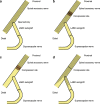Functional recovery following an end to side neurorrhaphy of the accessory nerve to the suprascapular nerve: case report
- PMID: 19902308
- PMCID: PMC2920384
- DOI: 10.1007/s11552-009-9242-3
Functional recovery following an end to side neurorrhaphy of the accessory nerve to the suprascapular nerve: case report
Abstract
The use of end-to-side neurrorhaphy remains a controversial topic in peripheral nerve surgery. The authors report the long-term functional outcome following a modified end-to-side motor reinnervation using the spinal accessory to innervate the suprascapular nerve following a C5 to C6 avulsion injury. Additionally, functional outcomes of an end-to-end neurotization of the triceps branch to the axillary nerve and double fascicular transfer of the ulnar and medial nerve to the biceps and brachialis are presented. Excellent functional recoveries are found in respect to shoulder abduction and flexion and elbow flexion.
Electronic supplementary material: The online version of this article (doi:10.1007/s11552-009-9242-3) contains supplementary material, which is available to authorized users.
Figures



Similar articles
-
Repair of brachial plexus lesions by end-to-side side-to-side grafting neurorrhaphy: experience based on 11 cases.Microsurgery. 2005;25(2):126-46. doi: 10.1002/micr.20036. Microsurgery. 2005. PMID: 15389968
-
Reconstruction of C5 and C6 brachial plexus avulsion injury by multiple nerve transfers: spinal accessory to suprascapular, ulnar fascicles to biceps branch, and triceps long or lateral head branch to axillary nerve.J Hand Surg Am. 2004 Jan;29(1):131-9. doi: 10.1016/j.jhsa.2003.10.013. J Hand Surg Am. 2004. PMID: 14751116
-
Long-term clinical outcomes of spinal accessory nerve transfer to the suprascapular nerve in patients with brachial plexus palsy.Acta Neurochir (Wien). 2016 Sep;158(9):1801-6. doi: 10.1007/s00701-016-2886-1. Epub 2016 Jul 7. Acta Neurochir (Wien). 2016. PMID: 27383201
-
[Paralytic shoulder secondary to post-traumatic peripheral nerve lesions in the adult].Acta Orthop Belg. 1999 Mar;65(1):10-22. Acta Orthop Belg. 1999. PMID: 10216997 Review. French.
-
Outcomes of Single versus Double Fascicular Nerve Transfers for Restoration of Elbow Flexion in Patients with Brachial Plexus Injuries: A Systematic Review and Meta-Analysis.Plast Reconstr Surg. 2019 Jul;144(1):155-166. doi: 10.1097/PRS.0000000000005720. Plast Reconstr Surg. 2019. PMID: 31246823
Cited by
-
Side-to-side neurorrhaphy for high-level peripheral nerve injuries.Acta Neurochir (Wien). 2012 Mar;154(3):527-32. doi: 10.1007/s00701-011-1264-2. Epub 2012 Jan 5. Acta Neurochir (Wien). 2012. PMID: 22231778 Free PMC article.
-
Neurite outgrowth on electrospun PLLA fibers is enhanced by exogenous electrical stimulation.J Neural Eng. 2014 Aug;11(4):046002. doi: 10.1088/1741-2560/11/4/046002. Epub 2014 Jun 3. J Neural Eng. 2014. PMID: 24891494 Free PMC article.
-
Optimal Technique for Cutting Peripheral Nerves in Nerve Transfer Surgery: A Survey of Peripheral Nerve Surgeons.Plast Reconstr Surg Glob Open. 2024 Sep 13;12(9):e6162. doi: 10.1097/GOX.0000000000006162. eCollection 2024 Sep. Plast Reconstr Surg Glob Open. 2024. PMID: 39281093 Free PMC article.
-
Nerve Transfers-A Paradigm Shift in the Reconstructive Ladder.Plast Reconstr Surg Glob Open. 2019 Jun 25;7(6):e2290. doi: 10.1097/GOX.0000000000002290. eCollection 2019 Jun. Plast Reconstr Surg Glob Open. 2019. PMID: 31624686 Free PMC article.
-
Supercharge nerve transfer to enhance motor recovery: a laboratory study.J Hand Surg Am. 2013 Mar;38(3):466-77. doi: 10.1016/j.jhsa.2012.12.020. Epub 2013 Feb 5. J Hand Surg Am. 2013. PMID: 23391355 Free PMC article.
References
-
- Asaoka K, Sawamura Y. Hypoglossal-facial nerve side-to-end anastomosis. J Neurosurg. 1999;91:163–164. - PubMed
LinkOut - more resources
Full Text Sources
Miscellaneous

